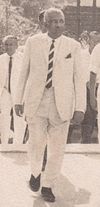Sri Lankan parliamentary election, 1965
|
|
||||||||||||||||||||||||||||||||||
|---|---|---|---|---|---|---|---|---|---|---|---|---|---|---|---|---|---|---|---|---|---|---|---|---|---|---|---|---|---|---|---|---|---|---|
|
||||||||||||||||||||||||||||||||||
|
151 seats to the House of Representatives of Ceylon 76 seats were needed for a majority |
||||||||||||||||||||||||||||||||||
|
||||||||||||||||||||||||||||||||||
|
||||||||||||||||||||||||||||||||||
Sirimavo Bandaranaike
Sri Lanka Freedom Party
Dudley Senanayake
United National Party
General elections were held in Ceylon (now Sri Lanka) in March 1965.
The SLFP government of Sirimavo Bandaranaike lost its majority in December 1964 when some MPs deserted it over the nationalization of Lakehouse Newspapers.
Bandaranaike's program of extensive nationalization had alarmed many of the island's business interests, which rallied to the United National Party. The economy had been stagnant, and rationing had been imposed in the face of persistent food shortages.
The UNP promised to form a National Front government to oppose the SLFP and its Marxist allies. UNP leader Dudley Senanayake promised cabinet posts both to the small Sinhala nationalist parties and the Illankai Tamil Arasu Kachchi (Federal Party).
The UNP did not obtain a majority, but was able to govern as a National Front with the ITAK's support.
...
Wikipedia


